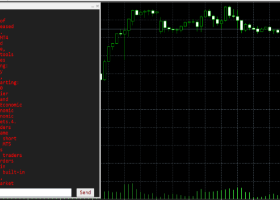Unveiling the Trend:
Using Moving Averages for Trading Decisions
Moving Averages (MAs) are a cornerstone of technical analysis, offering a simple yet powerful way to gauge trends and inform trading decisions. This article equips you with various methods to identify trends using moving averages, along with entry, profit target, and stop-loss strategies for each approach.

1. Price and Moving Average Relationship:
The most basic approach involves a single MA. Here’s how to interpret the relationship between price and the MA:
- Upward Slope (Upward Trend): The MA slopes upwards, indicating prices are generally rising. Price action tends to stay above the MA.
- Downward Slope (Downward Trend): The MA slopes downwards, suggesting a decline. Price action tends to stay below the MA.
Trading Strategy:
- Buy: Look to enter long positions (buy) when the price decisively breaks above an upward-sloping MA.
- Sell: Conversely, consider short positions (sell) when the price breaks below a downward-sloping MA.
Profit and Loss Limits:
- Profit Target: Set take-profit orders a reasonable distance above the MA in an uptrend, or below the MA in a downtrend. The distance can be based on a fixed amount or a multiple of the average true range (ATR).
- Stop-Loss: Place stop-loss orders below the MA in an uptrend, or above the MA in a downtrend to limit losses if the trend reverses.
2. Moving Average Crossovers:
This method involves using two MAs with different lengths. A common combination is the 50-day and 200-day MA. Here’s how to interpret the crossovers:
- Golden Cross (Bullish): The shorter MA (e.g., 50-day) crosses above the longer MA (e.g., 200-day). This signals a potential shift towards an uptrend.
- Death Cross (Bearish): The shorter MA crosses below the longer MA. This suggests a possible trend reversal towards a downtrend.
Trading Strategy:
- Buy: Enter long positions when a golden cross occurs.
- Sell: Initiate short positions on a death cross confirmation.
Profit and Loss Limits:
- Similar to the single MA method, set profit targets based on technical indicators or a multiple of ATR, placing stop-loss orders above/below the relevant MA used in the crossover.

3. Multiple Moving Averages:
This strategy utilizes a band of MAs with varying lengths (e.g., 10-day, 50-day, 200-day). By observing the price’s interaction with this band, you can gain a more nuanced understanding of trend strength.
- Price consistently above multiple MAs: Suggests a strong uptrend.
- Price consistently below multiple MAs: Indicates a strong downtrend.
- Price fluctuating between multiple MAs: May signal a consolidation phase or a weaker trend.
Trading Strategy:
- Buy: Look for long entries when the price breaks decisively above the entire MA band, especially after a period of consolidation.
- Sell: Conversely, consider short positions when the price breaks below the entire MA band.
Profit and Loss Limits:
- Profit targets can be based on the width of the MA band, while stop-loss orders can be placed just outside the breached area of the MA band.
Remember:
- Moving Averages lag: They react to past price movements, not predict the future. Be mindful of false signals, especially during volatile markets.
- Moving Average Length: The chosen MA lengths impact sensitivity. Shorter MAs react faster but generate more noise, while longer MAs react slower but provide smoother signals.
- Combine MAs with other indicators: Consider using confirmation from price action patterns or technical indicators to strengthen your trading signals.
- Market Volatility: During volatile periods, false signals and whipsaws are more common. Adjust your stop-loss limits accordingly.
- Practice proper risk management: Always adhere to strict stop-loss placement to limit potential losses.
- Multiple Timeframes: Analyze trends on multiple timeframes (daily, weekly) to confirm the overall direction.
Additional Considerations:
By understanding these methods and their limitations, you can leverage moving averages to identify trends and make informed trading decisions. Remember, no single indicator is perfect. Combine MAs with other technical analysis tools and practice proper risk management for successful trading.
Disclaimer: This article is for informational purposes only and should not be considered financial advice. Please consult with a qualified financial advisor before making any investment decisions.
Happy trading
may the pips be ever in your favor!



